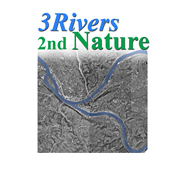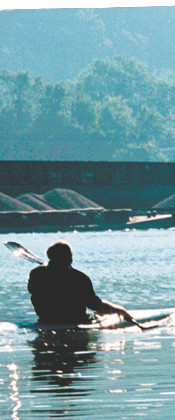Home > Rivers Re-valued> Water Trails
The Allegheny County River Dialogue: Water Trails
(2004)
On the following pages you will see some practical and
some fanciful ideas about our rivers. This report provides
documentation of “River Dialogue” events; the ideas and
concepts that emerged in discussions between citizens,
experts, planners, and public officials. These first steps
might provide the seeds that mature into a regional water trail. The next step will be for citizens to work (criticizing,
clarifying, and developing these concepts] with local
environmental organizations, communities, and decision
makers who have taken an interest in this process. Then,
if funding is available, design teams can be assembled to
create plans that help establish recreational use as a major
element of our regional rivers.
What is a Water Trail?
\Water trails are similar to bike trails; they provide access to
places of interest, communities, and natural places. They are
also open to all types of users. Water trails are used by boat
owners, nature enthusiasts, weekend recreationalists, as
well as tourists. A typical water trail might include small-boat
launches, shore access, overnight campsites, boat storage,
and interpretive signage highlighting significant historical,
geological, and environmental information. Additional amenities often featured on and which benefit from a water
trail include parks, restaurants, and shops located within
adjacent communities.
OUR Rivers!
Historically, rivers were the highways of our early explorers,
connecting important sites by clear, unobstructed routes. In
our recent history, the rivers were chiefly valued as avenues
for commerce and industry and sinks for industrial and
municipal wastes. Today, overcrowded roads and renewed
interest in recreation are compelling people to rediscover
their rivers and streams. Water quality is improving.
Recreational use and its attendant economy are showing
signs of vitality. Despite all of this, industrial river use
still has powerful advocacy through institutions like the
Port of Pittsburgh Commission. Under its current director,
James McCarville, the Port of Pittsburgh still focuses upon
raw material transport and industrial development. One
of their major projects was to help instigate the redesign
and construction of the dams on the Monongahela river,
creating a 32 mile open water pool from Braddock PA to
North Charleroi PA. While the primary goal was to stabilize
industry and retain existing levels of port activity, the
recreational value of the largest open water pool in Allegheny,
Washington, Westmoreland, and Fayette Counties is
incredibly significant. The future will tell us if this bold and
expensive ($750 Million) project stabilizes the industrial
economy, simultaneously creating the most significant river
recreational opportunity in Western Pennsylvania. River
transport is significantly cheaper than railroad or truck
transportation, but, to date, the goods transported are
primarily minerals, petroleum, and chemicals, all in bulk
form. Of course, river recreation and its range of economic
interests do not (as of yet) have the advocacy or attention
of the Port of Pittsburgh Commission. So, it’s up to you,
the user, to speak your mind about your rivers! Maybe one
day the Port of Pittsburgh Commission will have a “River
Recreation” link on their website alongside the existing links
to Transportation, Industrial Development, and Smart Barges.
Smarter, cleaner, and greener river use is in our future!
Your Rivers? YES! The rivers and their underlying land is
held in a “public trust.” Rivers cannot be bought, sold, or
developed unless it promotes a public purpose. We have
a right to use the surface of our waterways; we also have a
right to access those waterways (and oh, by the way, we have a right to clean water but that is yet another story). What will the future hold? What will our rivers look like in thirty years? How will we be using them? In a democratic society, the
future evolves out of our collective desires and the forces of
the market economy. Kayaking, motor boating, fishing and
other water sports are on the rise. Water quality is improving.
Fish species, wildlife, and forest growth that were once
believed lost from the area for good are returning. Man acts
and nature reacts, and always resilient, nature recovers over
time. We have some decisions to make about land and water
as their use-value changes. The question is, how do you see
the future of the region, its waterfront, your neighborhood?
What river-future do you have in mind for your children?


